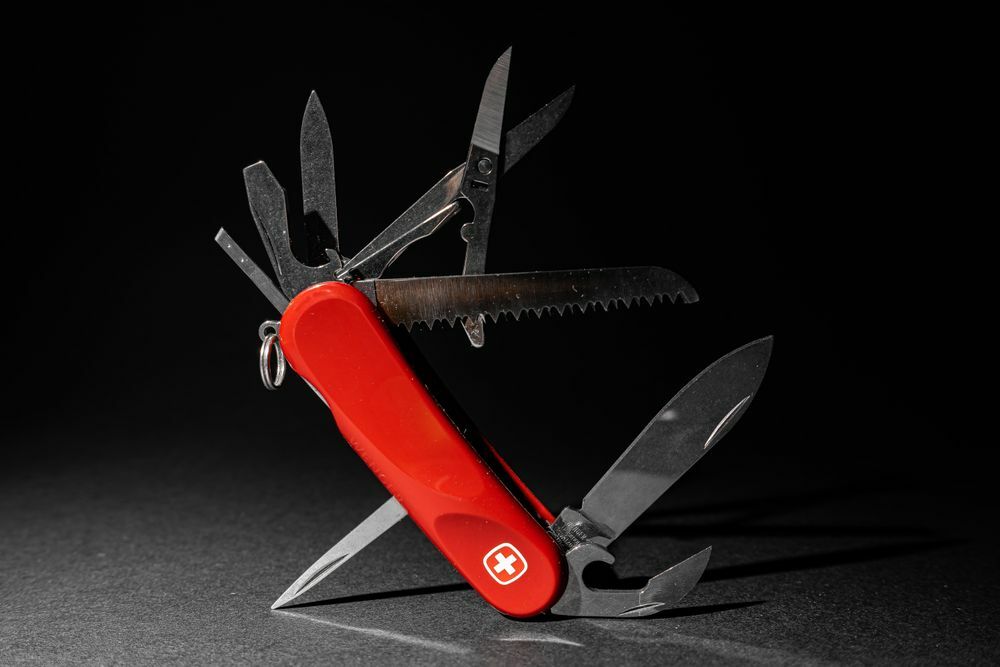Embracing the joined-up approach
crowdEngage specialises in providing a joined-up experience for audiences. To do that, we do a lot of integrating in the background. As part of the standard customer journey, we bridge the gaps between four or five systems in a venue, from ticketing to EPOS, scanning, live chat, data capture for marketing platforms, and other systems too. So joining systems together is something we do a lot of, and it’s something we’re quite passionate about!
But why do we care so much about making in-venue systems play nicely together? At crowdEngage, we think about a joined-up approach not just as a nice-to-have, but also as a competitive advantage for venues that adopt it.

An analogy
One of my favourite ways of thinking about software is with this analogy.
A Swiss Army knife is a really useful little gadget and it does an OK job on all sorts of things. But if you had some serious DIY to do and that was your only tool, it would drive you up the wall.
If you go into the procurement process looking for one all-singing, all-dancing system that does everything that your organisation needs it to do, this is what you’ll often end up with. A system that technically does do all of those things, but doesn’t necessarily do any of them very well.
Instead what you want is a collection of specialised tools, each with its own purpose and focus, that work well together. When you're armed with a well-equipped toolbox, you can achieve more, whether you're putting up a shelf or, for example, creating a multi-faceted audience experience in a performing arts venue.

Creating a joined-up organisation
Why can you achieve more? For a start, your teams will be more productive. If a team is stuck using software that works really well for one department but doesn’t particularly suit their own requirements, they’re not going to be very happy and they’re not going to be able to do their best work.The other staff-related benefit is ease of training - staff don’t have to learn multiple systems — each department can carry on using the tools with which they are most familiar.
Joining up those systems results in a joined-up organisation, which means you can operate your venue in the way that your customers already see you. When audience members come to a venue, they don’t see a security team, a front of house team, a bar team, a box office team. They see the venue as one organism.
If we can live up to that perception, we’ll offer a better experience for our audiences by removing the friction that can sometimes crop up at the boundaries of each team’s area of responsibility. And if we’re offering a better experience, that comes with real, measurable benefits — and not just in terms of immediate secondary spend.
It’s well established that it’s much more expensive to attract a new customer than it is to retain an existing one. So if we provide a great experience to our existing customers and we remove any friction from their visit, we can make sure there’s nothing that detracts from their enjoyment of the event they’ve come to see. And if they’re having a good time, it’s going to be much easier to get them back.
Some pointers for procurement
A seamlessly integrated software estate starts with a thoughtful and future-proofed procurement process. It sounds like an obvious point, but integrating is so much easier if you've already put in systems that are flexible enough to be integrated. Here are some tips.
Do you really need the integration?
This may be a little bit of a contradictory point given everything I've written above but — not everything has to be joined up. Don’t integrate for the sake of integrating. Make sure you’ve got a specific business goal in mind that joining two systems will help you accomplish. And make sure that the integration is going to get you there, especially if it's a pre-built integration that your system says it supports out of the box.
Look for the API
During procurement, look for open, powerful APIs, even if you don't need them yet. Can you find the documentation easily? That's a good sign. Does it look like you can create, retrieve, and update all the things you can do with your mouse and keyboard when you log in to the system?
And finally, does it cost any extra or require additional set up? If you'd like a helping hand in evaluating an API, it's a good shout to find a consultant with experience in this area and ask them to cast an eye over it. We're happy to make recommendations and introductions, so feel free to drop us a line.
Has it been done before?
Talk with your providers about their integrations – and ask for references. If it's an out-of-the-box feature for this particular system, talk to people who use it and make sure it does what has been promised. Some integrations are more useful than others, but they all look the same in a list of bullet points on a pitch document!
If it's something you're getting built from scratch, ask about other similar integrations they've done – and again, chat to the people who are using them in practice.
Keep talking
Finally, keep talking to your existing suppliers about new systems you're adding in across the organisation, and how they're working for you. Your software estate changes over time and if you keep your providers in the loop they might be able to spot when there's an opportunity to deliver a neat integration – or they might have already built one that you can switch on. (On a related note, it should go without saying, but suppliers – you need to keep talking to your venues too!)
Get in touch!
If you're interested in chatting more about APIs, integration, visitor experience, or anything else even tangentially related, I'm always keen to hear about how venues are getting on and what they're up to. You can reach me on Twitter here, or by email at hugh@crowdengage.com.This blog post is adapted from a presentation I gave at the Ticketing Professionals Conference 2022, in a session about the importance of integrating systems for customer experience.
Performing arts organisations and other venues use crowdEngage to cut down queues, grow revenue, and send customers relevant and up-to-date performance information along with their mobile tickets.
If you want to find out how it could work for your venue, or are just interested in what we’re up to at crowdEngage, please get in touch.